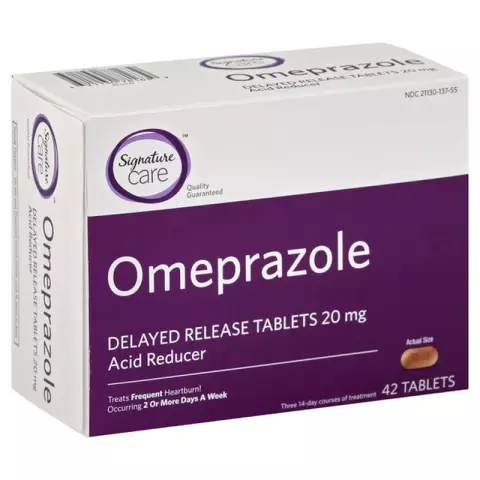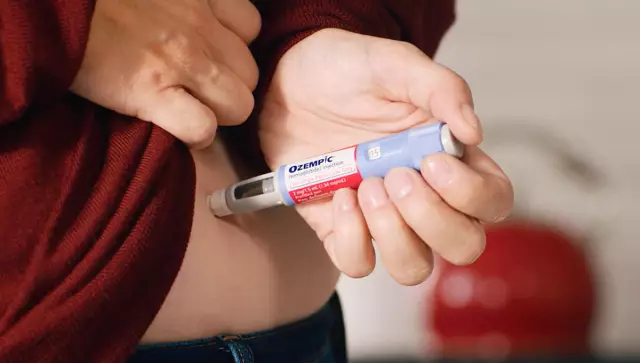- Author Rachel Wainwright [email protected].
- Public 2023-12-15 07:39.
- Last modified 2025-11-02 20:14.
Norepinephrine
Norepinephrine: instructions for use and reviews
- 1. Release form and composition
- 2. Pharmacological properties
- 3. Indications for use
- 4. Contraindications
- 5. Method of application and dosage
- 6. Side effects
- 7. Overdose
- 8. Special instructions
- 9. Application during pregnancy and lactation
- 10. Use in the elderly
- 11. Drug interactions
- 12. Analogs
- 13. Terms and conditions of storage
- 14. Terms of dispensing from pharmacies
- 15. Reviews
- 16. Price in pharmacies
Latin name: Norepinephrine
ATX code: C01CA03
Active ingredient: norepinephrine (Norepinephrine)
Producer: LLC "Ellara" (Russia)
Description and photo update: 2019-08-07

Norepinephrine is an alpha adrenergic agonist.
Release form and composition
The drug is produced in the form of a concentrate for the preparation of a solution for intravenous (i / v) administration: clear, colorless or slightly yellowish liquid (4 ml in a neutral glass ampoule, 5 ampoules in a blister strip, 1 or 2 packs in a cardboard box, or 5 or 10 ampoules with an ampoule scarifier; 8 ml in an ampoule of neutral glass, in a blister strip 5 ampoules, in a cardboard box 1 or 2 packs with an ampoule scarifier; if the ampoules have a point or a break ring, the scarifier is not inserted; for hospitals: in cardboard boxes 4, 5 or 10 blister packs with ampoules, or in cardboard boxes of 50 or 100 packs. Each pack also contains instructions for the use of Norepinephrine).
1 ml of concentrate contains:
- active substances: norepinephrine bitartrate monohydrate (in terms of norepinephrine bitartrate) - 2 mg (corresponds to norepinephrine base in an amount of 1 mg);
- additional components: sodium metabisulfite (sodium disulfide), 1 M hydrochloric acid solution or 1 M sodium hydroxide solution, sodium chloride, water for injection.
Pharmacological properties
Pharmacodynamics
Norepinephrine belongs to the group of biogenic amines and is a neurotransmitter. The active substance is characterized by a powerful stimulating effect on α-adrenergic receptors and a moderately stimulating effect on β 1 -adrenergic receptors. If it enters the bloodstream, even in small concentrations, the drug leads to generalized vasoconstriction, with the exception of the coronary vessels, in which it causes expansion as a result of indirect action (due to more intense oxygen consumption). Thanks to this effect, the funds increase the strength and (in the absence of vagotonia) the frequency of myocardial contraction, which causes an increase in the stroke and cardiac output.
The mechanism of action of norepinephrine provides an increase in both systolic and diastolic blood pressure (BP), as well as central venous pressure and total peripheral resistance (OPSS). The cardiotropic effect of the substance is associated with its activity against β l -adrenergic receptors of the heart.
Pharmacokinetics
After intravenous administration, the effect of norepinephrine appears rather quickly, but it is observed for a short period of time. The half-life (T ½) of the active substance is on average 1-2 minutes. The agent is rapidly excreted from plasma as a result of reuptake and metabolic transformation, weakly passes through the blood-brain barrier.
Biotransformation of norepinephrine is carried out in the liver and other tissues by methylation by catechol-O-methyltransferase and deamination by monoamine oxidase (MAO). The final metabolite of the substance is 4-hydroxy-3-methoxymanic acid. Intermediates of metabolic transformation include 3,4-dihydroxymandelic acid and normetanephrine. Metabolites are eliminated mainly together with urine, mostly in the form of sulfate conjugates and to a lesser extent - in the form of glucuronides.
Indications for use
The use of norepinephrine is recommended for rapid recovery of blood pressure in case of an acute decrease.
Contraindications
Absolute:
- arterial hypotension due to hypovolemia, excluding cases when the drug is used to maintain coronary and cerebral blood flow until the end of therapy to replenish the circulating blood volume (BCC);
- planned cyclopropane and halothane general anesthesia (due to the increased risk of cardiac arrhythmias);
- severe hypoxia and hypercapnia;
- hypersensitivity to any component of the product.
Relative (given the mechanism of action of norepinephrine, the drug should be prescribed with extreme caution):
- recent myocardial infarction;
- acute heart failure;
- severe left ventricular failure;
- Prinzmetal's angina;
- violation of the rhythm of the heart during the infusion of the drug;
- insufficient blood circulation;
- thrombosis of the coronary, peripheral or mesenteric vessels (due to the increased threat of an increase in the infarction zone and the development of ischemia);
- diabetes mellitus or hyperthyroidism;
- pregnancy and the period of breastfeeding;
- elderly age.
Norepinephrine, instructions for use: method and dosage
Norepinephrine is for intravenous administration only.
The dose of the drug is determined by the doctor individually, taking into account the clinical condition of the patient.
In order to reduce the risk of extravasation and further necrosis, norepinephrine solution should be administered using central venous access devices. Before starting treatment or during its implementation, it is necessary to correct hypoxia, hypovolemia, hypercapnia, acidosis.
The recommended initial dose of the agent and the rate of administration vary from 0.1 to 0.3 μg / kg per minute. The infusion rate is progressively increased in steps by titration of 0.05-0.1 μg / kg per minute according to the observed pressor effect until the desired normotonia is reached. To achieve and maintain the latter, individual differences in dose are possible. The goal of treatment is to achieve the lower limit of the normal systolic blood pressure - 100-120 mm Hg. Art. taking into account the clinical condition of the patient. The individual dose is also determined depending on the patient's condition due to the high variability of the response to the treatment.
The use of a solution of the drug is required in combination with adequate replenishment of the BCC. It is necessary to beware of injecting the drug into the muscles and under the skin due to the threat of necrosis.
The concentrate must be diluted in a 5% dextrose solution; it cannot be mixed with other drugs. Depending on the methods of administration of the solution, it is recommended to dilute norepinephrine as follows:
- dropper: 20 ml of the concentrate is dissolved in 480 ml of dextrose solution;
- syringe infusion pump: 2 ml of the concentrate is dissolved in 48 ml of dextrose solution.
As a result of both variants of dilution in the prepared solution for intravenous administration, the final concentration of norepinephrine bitartrate is 0.08 mg / ml, which is equivalent to norepinephrine base - 0.04 mg / ml.
Once diluted, the infusion solution should be used within 12 hours.
If it is necessary to introduce a large volume of liquid, it is necessary to add a large amount of dextrose to the concentrate and, therefore, to use a solution with a lower concentration of active substance for administration. If a large volume of liquid is not desired, less dextrose should be added to the concentrate to produce a more concentrated solution.
The infusion rate of the drug is calculated taking into account the patient's weight, dosage and amount of norepinephrine bitartrate.
The calculation of the rate of infusion of a solution of norepinephrine with a concentration of 0.08 mg / ml * [indicated the rate of infusion (ml / h) / dosage (μg / kg / min) / amount of norepinephrine bitartrate (mg / h)]:
- weight 50 kg: 1.875 / 0.05 / 0.15; 3.75 / 0.1 / 0.3; 7.5 / 0.2 / 0.6; 11.25 / 0.3 / 0.9; 18.75 / 0.5 / 1.5; 37.5 / 1/3; 75/2/6;
- weight 60 kg: 2.25 / 0.05 / 0.18; 4.5 / 0.1 / 0.36; 9 / 0.2 / 0.72; 13.5 / 0.3 / 1.08; 22.5 / 0.5 / 1.8; 45/1 / 3.6; 90/2 / 7.2;
- weight 70 kg: 2.625 / 0.05 / 0.21; 5.25 / 0.1 / 0.42; 10.5 / 0.2 / 0.84; 15.75 / 0.3 / 1.26; 26.25 / 0.5 / 2.1; 52.5 / 1 / 4.2; 105/2 / 8.4;
- weight 80 kg: 3 / 0.05 / 0.24; 6 / 0.1 / 0.48; 12 / 0.2 / 0.96; 18 / 0.3 / 1.44; 30 / 0.5 / 2.4; 60/1 / 4.8; 120/2 / 9.6.
* If a different dilution of the concentrate is used, it is necessary to change the value of the solution concentration in the formula used: infusion rate (ml / h) = dosage (μg / kg / min) × patient weight (kg) × 60 (min) × 0.001 / 0.08 mg / ml.
In order to avoid the appearance of arterial hypertension, the dose of the solution, the duration and rate of its administration are set based on the data of the control of cardiac activity and under the obligatory careful control of blood pressure (until normotonia is reached, every 2 minutes and then every 5 minutes throughout the entire infusion).
Treatment with the drug should be discontinued gradually, since abrupt withdrawal increases the risk of acute hypotension. The course of therapy is from several hours to 6 days.
Side effects
- central nervous system: headache, weakness, insomnia, anxiety, vomiting, nausea, decreased attention, confusion, tremors, psychotic states, anorexia;
- cardiovascular system: tissue hypoxia and arterial hypertension; tachycardia, bradycardia (presumably reflexively due to an increase in blood pressure), ischemic disorders (associated with severe vasoconstriction, which can cause pallor and coldness of the face and limbs); a feeling of palpitations, arrhythmias, increased contractility of the myocardium due to the β-adrenergic effect of the drug on the heart (chronotropic and inotropic), acute heart failure; in the case of rapid intravenous infusion - chills, cooling of the extremities, headache, tachycardia;
- immune system: against the background of hypersensitivity to any component of norepinephrine - difficulty breathing, allergic reactions;
- respiratory system: pain in the mediastinum and sternum, difficulty breathing, shortness of breath, respiratory failure;
- organ of vision: acute glaucoma (in the presence of anatomical predisposition - closing the angle of the anterior chamber of the eyeball);
- urinary system: urinary retention;
- local reactions: irritation at the injection site or the development of necrosis.
Long-term administration of the drug in order to maintain blood pressure in the absence of restoration of the BCC can provoke the following undesirable reactions:
- decreased renal blood flow;
- pronounced visceral and peripheral angiospasm;
- tissue hypoxia;
- decreased urine production;
- increased serum lactate levels in the blood.
Against the background of hypersensitivity to the effects of norepinephrine (in particular, with hyperthyroidism), in the case of using high / usual doses, dyspeptic symptoms and a significant increase in blood pressure may appear, which may be accompanied by photophobia, headache, pallor of the skin, increased sweating, stabbing chest pain, vomiting.
Overdose
Symptoms of a norepinephrine overdose include: a significant increase in blood pressure, vasospasm of the skin, anuria, collapse. With the development of such adverse reactions associated with an overdose, it is recommended to reduce the dose if possible.
special instructions
The diluted norepinephrine solution should be clear. If a sediment, turbidity or discoloration was found in the solution before the infusion, its introduction is prohibited.
With a long course of treatment, there may be a decrease in plasma volume; in order to prevent the development of recurrent arterial hypotension against the background of drug withdrawal, correction is necessary.
If a heart rhythm disorder occurs during the infusion of the drug, it is necessary to reduce the dose.
The simultaneous use of norepinephrine with MAO inhibitors and antidepressants of the triptyline and imipramine types is not recommended due to the risk of a prolonged and significant increase in blood pressure.
In order to reduce the threat of extravasation, which can lead to tissue necrosis, it is necessary to constantly monitor the position of the needle in the vein when injecting the solution. Also, the site of injection of norepinephrine needs to be checked frequently for infiltration (free flow). Due to the vasoconstriction of the vein with increased wall permeability, there is a risk of the solution flowing into the tissue adjacent to the vein; in this case, in order to weaken the effect of local vasoconstriction, it is recommended to change the infusion site.
When the drug flows from the vessel or is injected outside the vein, blanching may occur and later, due to the vasoconstrictor effect of the drug on the blood vessels, tissue destruction. If the solution gets past the venous blood flow to the injection site, phentolamine should be injected in a dose of 5-10 ml, diluted in 10-15 ml of saline.
Application during pregnancy and lactation
The drug can contribute to the violation of placental blood circulation and the development of bradycardia in the fetus. Also, against the background of the use of norepinephrine, uterine contraction is possible, which can cause fetal asphyxia in late pregnancy.
During the period of breastfeeding, the agent must be used with caution, since there is no data on its ability to be excreted in breast milk.
During pregnancy / lactation, before the start of the infusion, the expected benefit from the use of the drug for the mother and the possible threat to the fetus / child should be carefully balanced.
Use in the elderly
Norepinephrine should be used with caution in elderly patients, as the elderly may be particularly sensitive to its effects.
Drug interactions
- alpha-adrenergic blockers (prazosin, doxazosin, thalazosin, phenoxybenzamine, terazosin, labetalol, phentolamine) and other drugs that exhibit alpha-adrenergic blocking activity (thioxanthenes, phenothiazines, loxapine, haloperidol): there is an anti-vasoconstrictor effect;
- cardiac glycosides, tricyclic antidepressants, quinidine: the threat of arrhythmias is aggravated;
- maprotiline, tricyclic antidepressants: there is a risk of increased pressor action, cardiovascular effects, arrhythmias and tachycardia;
- medicines for inhalation general anesthesia (cyclopropane, chloroform, methoxyflurane, halothane, isoflurane, enflurane): the threat of ventricular arrhythmias is increasing;
- linezolid, procarbazine, furazolidone, selegiline, MAO inhibitors: the pressor effect is prolonged and enhanced;
- antihypertensive drugs and diuretics: the therapeutic effect of norepinephrine decreases;
- nitrates: the antianginal effect is weakened;
- β-blockers: there is a mutual decrease in the effect;
- oxytocin, ergot alkaloids: increased vasopressor and vasoconstrictor action;
- thyroid hormones: the risk of coronary insufficiency on the background of angina pectoris is aggravated;
- doxapram, cocaine: the hypertensive effect is mutually enhanced.
Analogs
Norepinephrine analogs are: Norepinephrine Kaby, Norepinephrine, Norepinephrine Agetan, Norepinephrine, Levarterenol, Norexadrin, etc.
Terms and conditions of storage
Store in a place protected from light, out of reach of children, at a temperature not exceeding 25 ° C.
Shelf life is 2 years.
Terms of dispensing from pharmacies
Dispensed by prescription
Reviews of norepinephrine
There are practically no reviews of norepinephrine left by patients on medical sites, since this remedy is usually used in critical, life-threatening cases. In such situations, patients cannot adequately assess the effect of the drug, and sometimes they do not even know that it was used in the therapy. The effectiveness of treatment with an alpha-adrenergic agonist depends on the professionalism and experience of doctors who provide adequate intensive care.
Price for Norepinephrine in pharmacies
There is no reliable data on the price of norepinephrine, since the drug is currently not available in the pharmacy network. The cost of an analogue of the drug Noradrenaline Agetan, a concentrate for the preparation of a solution for intravenous administration (2 mg / ml), on average is: 10 ampoules of 4 ml - 1400 rubles, 8 ml - 1850 rubles.

Maria Kulkes Medical journalist About the author
Education: First Moscow State Medical University named after I. M. Sechenov, specialty "General Medicine".
Information about the drug is generalized, provided for informational purposes only and does not replace the official instructions. Self-medication is hazardous to health!






